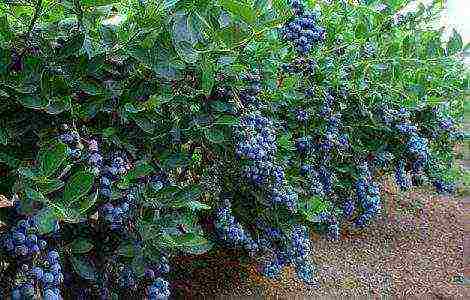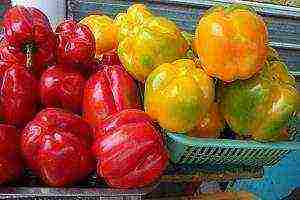Content
- 1 Self-fertile varieties of cherries
- 2 Early varieties of cherries
- 3 Medium ripening cherry varieties
- 4 Late varieties of cherries
- 5 Large varieties of cherries
- 6 Low-growing (dwarf) cherry varieties
- 7 The best varieties of cherries for the southern regions of Russia
- 8 The best cherry varieties for the northern regions
- 9 The most delicious cherry varieties for Siberia and the Urals
- 10 The best cherry varieties for the Moscow region, description and care
- 11 Description of cherry varieties
- 12 1. Volochaevka
- 13 2. Zhivitsa
- 14 3. Tamaris
- 15 4. Chocolate girl
- 16 5. Spunk
- 17 Which high-yielding cherry varieties are best grown?
- 18 The best self-fertile varieties of cherries for the garden
- 19 The best of low-growing cherry varieties
- 20 The most winter-hardy of the best cherry varieties
All varieties of cherries differ among themselves in various ways, whether it is the ripening time, the size of the fruit or the region of growth. The most frost-resistant cherries are those grown in the northern regions. (Ob, Ashinskaya, Blizzard), but the most productive and sweetest varieties grow in the south of the country (Lyubskaya, Shpanka, Garland). Cherries, early ripening the most stable, but their taste is much more sour (Shokoladnitsa, Molodezhnaya), medium ripening varieties are the golden mean (Vladimirskaya, Zhukovskaya, Turgenevka). Another sign is the presence of flowers of both sexes, that is, self-fertility (Apkhutinskaya, Pamyat Yenikiev). To choose the most suitable cherry variety, you need to know all their characteristics.
Self-fertile varieties of cherries
Self-fertile varieties include cherries that no additional pollination required, and they independently set both male and female flowers.
Apukhtinskaya
A medium-sized tree on which large and tasty heart-shaped fruits grow. The Apukhtinskaya variety begins its fruiting already in the second year after planting, refers to late ripening, the ripening of the crop falls in mid-August. The tree has good resistance to frost and drought, but it is also susceptible to fungal diseases.
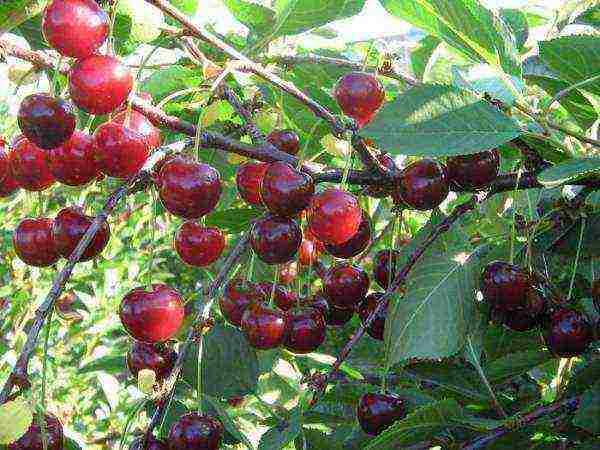 Cherry variety Apukhtinskaya
Cherry variety Apukhtinskaya
Memory of Yenikiev
The tree grows up to 3 meters in height, the crown is of medium density, spherical in shape. Fruit weight reaches 5 gramsso they can be considered large. The shape of the berries is oval, the color is dark red. Cherry pulp Yenikiev's memory is very tasty and juicy. The variety is distinguished by the presence of a large bone... The tree begins to bear fruit already at 3-4 years of age, the period of full ripening of the crop falls at the end of June. Up to 15 kilograms of fruit can be harvested from one cherry.... Possesses medium resistance to frost and drought.
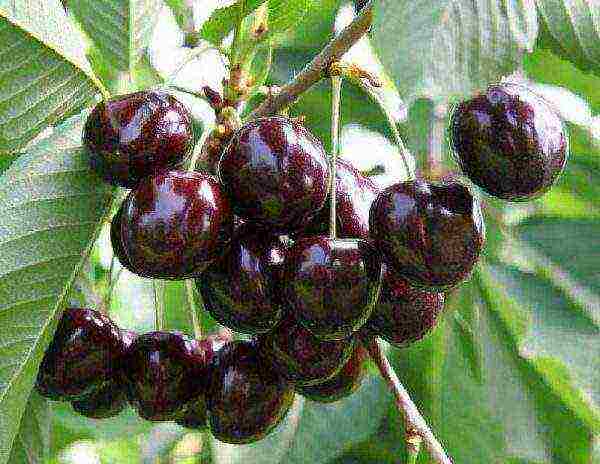 Cherry in Memory of Yenikeev
Cherry in Memory of Yenikeev
Also self-fertile varieties of cherries include Garland, Brunette, Cinderella, Shokoladnitsa, ErdiBetermo, Ksenia, Nochka, Vstrecha, etc.
Early varieties of cherries
Cherry varieties that ripen between early June and mid-July are called early cherry varieties.... Their berries are less sweet, and the trees have good frost resistance.
Chocolate girl
This cherry tree is of medium height, with a crown shape reminiscent of an inverted cone. The berries are distinguished by their sour taste and maroon color. The pulp is a deep red shade, dense, with an easily detachable bone... The Shokoladnitsa variety tolerates frost and drought well, is resistant to many diseases, and is self-fertile. Brings a stable harvest.
 Cherry Shokoladnitsa
Cherry Shokoladnitsa
Spunk
This variety is a cherry-cherry hybrid. A tall tree with freely growing branches resembles a ball in its shape. In addition, the attachment of the branches to the tree is rather weak, therefore, when the crop appears, there is a risk that they will begin to break. The taste of berries is sweet and sour, on average, their weight is 4 grams... Fruit color is dark red, rounded-flattened shape. The first crop of Spanka brings in 6-7 years of life, but at the age of 20, you can get up to 60 kilograms of cherries from a tree. Fruiting occurs from late June to early July... The variety is highly resistant to frost and drought and needs pollinators.
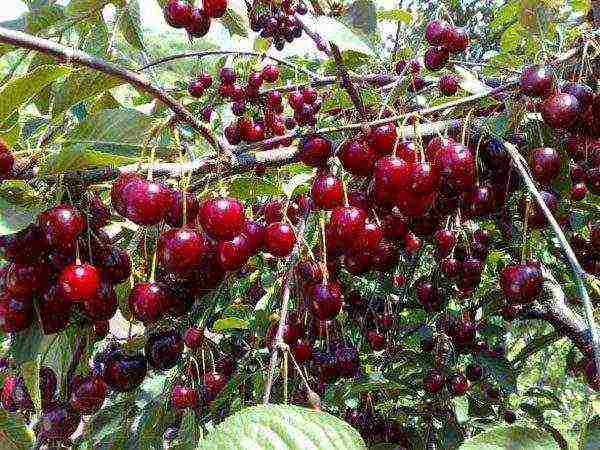 Cherry varieties Shpanka
Cherry varieties Shpanka
Youth
Shrub cherry, with a low, slightly drooping crown. The fruits of the Molodezhnaya variety are large in size, their weight can reach 4.8 grams, the skin and pulp have the same maroon color. The stone separates well, and a slight sourness is felt in the taste of the cherries themselves, such berries are perfect for preservation and freezing. The first crop appears on a 5-year-old tree, fruiting mainly occurs on last year's wood... Molodezhnaya is a frost-resistant variety. Has an average disease resistance.
 Shrub self-fertile cherry variety Molodezhnaya
Shrub self-fertile cherry variety Molodezhnaya
Miracle cherry
Arboreal cherry with medium vigor. The crown of the tree needs constant formation, with a free form of growth, it looks like a cone, and the fruits will accumulate at the very top. The taste of berries is dessert, sweet, in all their external characteristics they resemble cherries, can reach a weight of 9.5 grams. The variety is self-fertile and needs pollinators. The tree begins to bear fruit from the age of 3 years, while bringing a large, stable harvest. You can harvest the fruits already at the beginning of June. Miracle cherry is resistant to frost and most diseases.
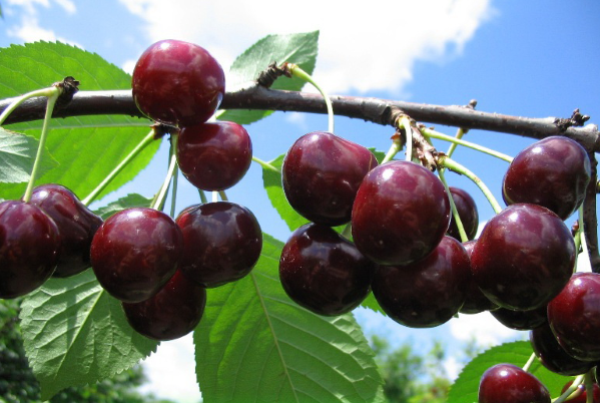 Variety Miracle cherry
Variety Miracle cherry
Baby
The tree is of medium height and spherical in shape. It bears beautiful fruits of dark red color with a pleasant sweet and sour taste, the stone is easily separated from the pulp. The shape of the berries is round, evenly flattened, the weight reaches 5 grams... Variety Malyshka Differs in good transportability, immunity to fungal diseases and frost resistance. Productivity is inferior to other varieties, from one tree you can get 17 kilograms of cherries. Their full maturity falls at the end of June.
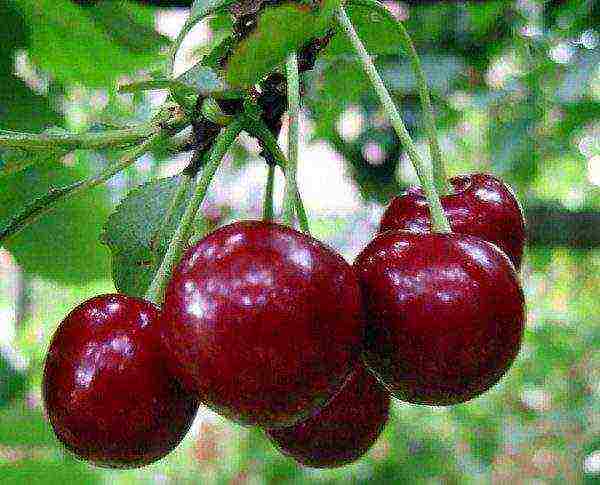 Cherry variety Baby
Cherry variety Baby
There are also other early ripening varieties of cherries. For example, Memory, Bulatnikovskaya, Enikeeva, Bagryanka, Sania, Vasilievskaya.
Medium ripening cherry varieties
Mid-early cherries are called cherries that ripen in the middle of summer; they have the best taste.
Vladimirskaya
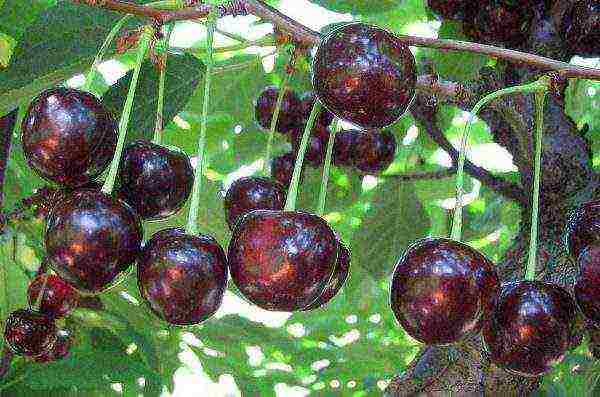 Cherry fruits Vladimirskaya
Cherry fruits Vladimirskaya
Vladimirskaya - one of the oldest varieties grown in the central regions of Russia. Bushy tree, grayish bark... The branches grow downward, so the shape of the crown is called weeping. 5-7 flowers of a delicate white color are collected on one inflorescence. Leaves of a matte green shade, elongated, gradually sharpening towards the base and apex, the edge is double-serrate. Fruits are sweet and sour, slightly fibrous, well suited for any form of processing. The color of the skin is dark red, almost black, the weight of the berries does not exceed 3.7 grams, the shape is round-flattened. The first fruiting occurs in the 3rd year of life, cherry ripening occurs at the end of July. This variety tolerates winter cold well, but spring frosts can completely destroy the inflorescences, and, accordingly, the entire crop. It grows best in central Russia, with good care it can bear 25 kilograms of fruit. In the northern regions, the yield drops sharply to 6-7 kilograms.... Vladimirskaya needs pollinators and additional protection from diseases and pests. If the berries are not picked in time, they will begin to crumble very quickly.
Zhukovskaya
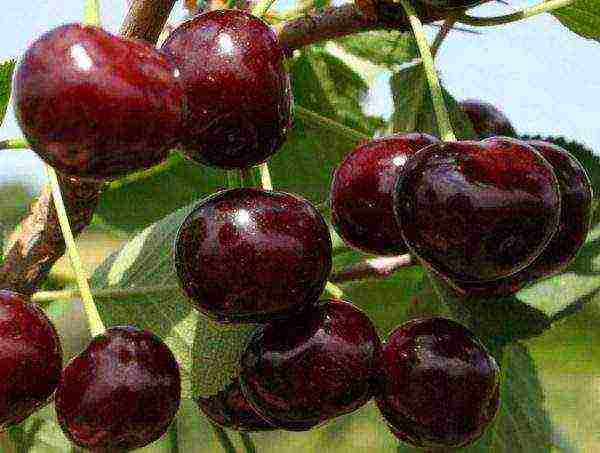 Cherry variety Zhukovskaya
Cherry variety Zhukovskaya
Cherry grows up to 2.5 meters, the crown of the tree is spreading, but rare. Leaves are narrow, oval, dark green in color. Forms inflorescences of 3-4 flowers, medium-sized with rounded petals. Fruiting occurs on last year's annual wood... Most often, the berries are located singly, sometimes in two. Cherry varieties Zhukovskaya medium size, up to 4 grams, dark red, heart-shaped. The pulp is tender, juicy, with a dessert taste. Disease resistance is average.
Kharitonovskaya
 Cherry variety Kharitonovskaya
Cherry variety Kharitonovskaya
The tree grows to medium size, the flowers are large, white. The berries themselves are evenly rounded, the skin is bright red, the flesh is orange. They have a sweet and sour taste, the stone is easily separated... Good immunity to various diseases, normal frost resistance. The Kharitonovskaya variety needs additional pollination.
Turgenevka
 Cherry varieties Turgenevka
Cherry varieties Turgenevka
A cherry tree of this variety grows up to 3 meters, forms inflorescences of 4 white flowers. Fruiting occurs on bouquet twigs. Berries are broadly heart-shaped, large in size, weighing up to 6.5 grams... The skin color is dark red, the pulp is juicy, sour-sweet, the taste is normal. The first harvest ripens at 5-6 years of age, full ripening of fruits occurs in early July. Turgenevka tolerates winter frosts well, but may die when spring frosts appear... Possesses high resistance to diseases, requires pollinators. The variety produces a good, stable yield.
Morozovka
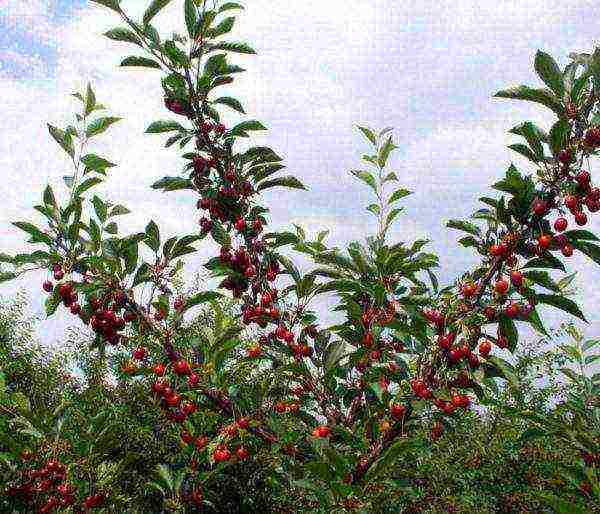 Cherry with fruits grade Morozovka
Cherry with fruits grade Morozovka
The tree grows medium in size, the crown is wide, spreading. Fruiting occurs on bouquet twigs, the berries are round in shape with a fossa at the stalk, the weight can reach 5.5 grams. The skin is dark burgundy, the pulp is juicy, dessert taste with an easily detachable bone... Such berries are suitable both for fresh consumption and for processing, they are well transported. The tree begins to bear fruit at the age of 3 years; the fruit of the Morozovka variety ripens at the end of July. The yield is stable, up to 500 kilograms per hundred square meters... The variety is resistant to frost, drought and disease. Needs pollinators.
Also, the average ripening period is possessed by the varieties Radonezh, Vstrecha, Toy, Nochka.
Late varieties of cherries
Late varieties are the last to ripen, in late summer and early autumn..
Lyubskaya
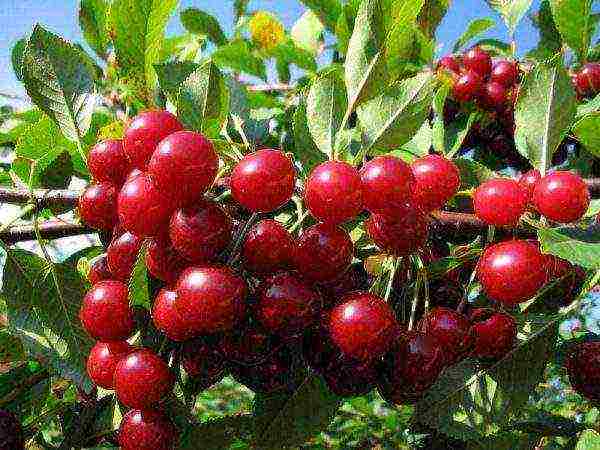 Harvest of cherries of the variety Lyubskaya
Harvest of cherries of the variety Lyubskaya
The variety is intended for cultivation in central and southern Russia, it is very demanding on soil fertility and quality of care. Produces a large crop with blood-red, transportable fruits with a mediocre taste... These berries are ideal for processing. The tree is self-fertile, but with additional pollination it gives higher yields. A young tree bears up to 26 kilograms of fruit, and an adult up to 60. Lyubskaya does not have frost resistance, it is often exposed to various diseases.
Generous
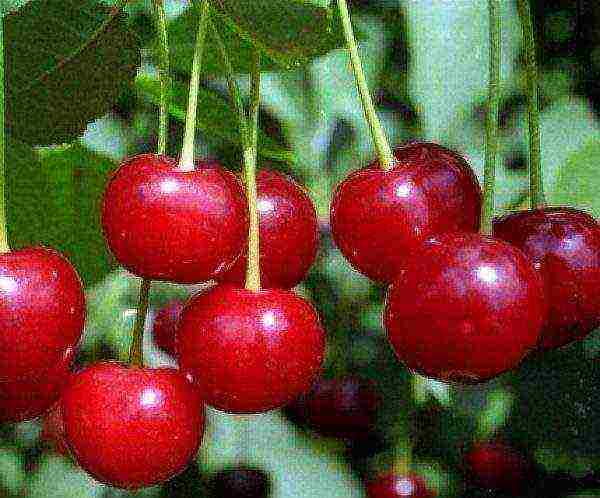 Cherry variety Generous
Cherry variety Generous
Bushy cherry with upturned shoots. The weight of one cherry is about 4 grams, its shape is round, the color is bright red. Pulp with good taste, the stone is easily separated. The presentation of the berries is at the highest level, they are resistant to cracking. Variety Generous gives an annual, bountiful harvest, ripens in autumn... The tree gives its first cherries as early as 3-4 years. Generous is distinguished by high frost resistance, it can easily endure even spring frosts, the variety also does not lend itself to attacks by pests, and tolerates drought well. Susceptible to diseases, especially fungal diseases.
Robin
 Cherry variety Malinovka
Cherry variety Malinovka
A tree of medium height with a spherical crown.Leaves with a wide plate, glossy, green, crenate edge. The cherries are small, on average, the weight of one berry is 3-3.5 grams, the shape is round... The taste is sweet and sour, pleasant, the pulp is dense. The variety gives an annual, bountiful harvest that ripens in early August. The robin needs additional pollinators and protection from disease. Frost resistance - medium.
Other varieties of late-ripening cherries are Zhuravka, Polevka, Rubinovaya, Lotovaya, Rusinka, Gorkovskaya.
Large varieties of cherries
Cherry varieties with large dessert berries are not inferior to sweet cherries in their taste. But compared to other varieties, they are whimsical to climatic conditions and quality of care.
Consumer goods Black
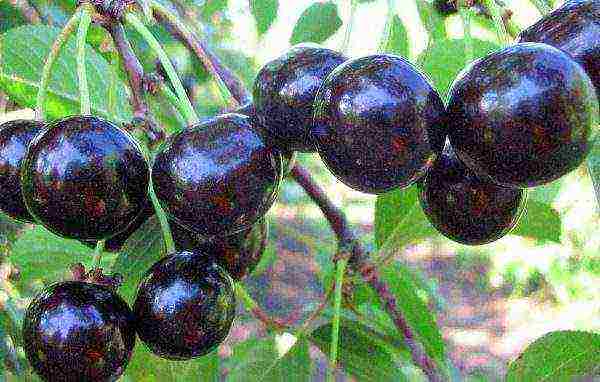 Cherry variety Consumer goods Black
Cherry variety Consumer goods Black
A low-growing tree with very tasty berries with a dark skin of almost black color. The pulp is juicy, tender, with an easily detachable bone. The fruits ripen Consumer goods Black in early June, the yield of the variety is moderate... Has a weak resistance to frost. The tree needs additional pollination.
Volochaevka
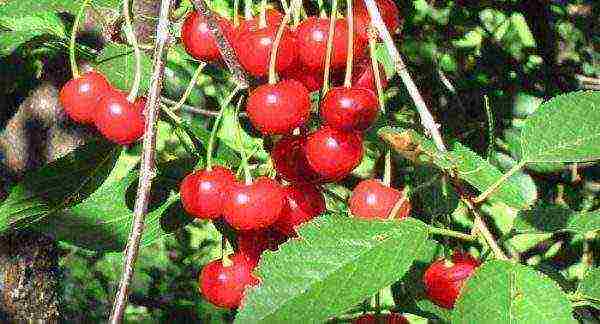 Cherry Volochaevka
Cherry Volochaevka
A medium-sized tree is capable of producing an annual harvest. The berries are sweet, juicy with firm pulp and easily removable pits. Ripens in mid-July. The variety does not tolerate frost well, in the rainy season there is a risk of rot... Volochaevka forms both female and male flowers, self-fertile.
A meeting
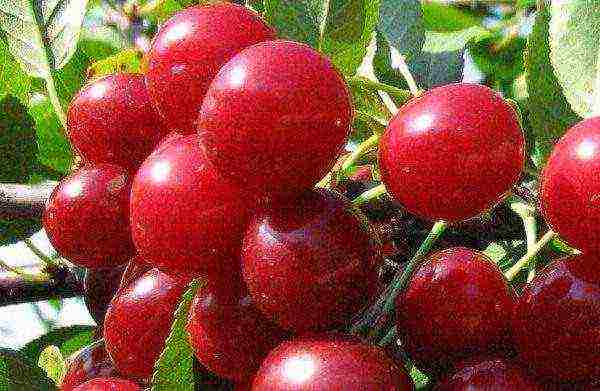 Cherry variety Meeting
Cherry variety Meeting
A small tree, the weight of the fruits of which exceeds the mark of 10 grams. The berries are bright red, with a tender and juicy pulp... The harvest of the Vetska variety is stable and annual, ripening falls on the 20th of June. The variety tolerates frost and drought well, and is resistant to fungal diseases.
Also, varieties with large fruits include Molodezhnaya, Dessert Morozova, Pamyat Yenikeev, Podbelskaya, Minx, Toy, etc.
Low-growing (dwarf) cherry varieties
Trees of such varieties grow no higher than 2.5 meters.... They are very convenient for breeding and harvesting, therefore they are very popular among gardeners.
Anthracite
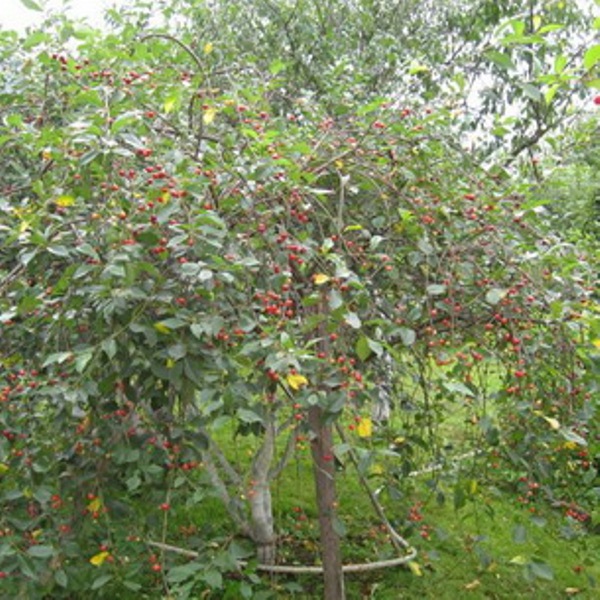 Common cherry Anthracite
Common cherry Anthracite
A bushy cherry with a wide crown, its maximum growth is 2 meters. The skin of the berries is dark, almost black in color, the pulp is blood red.... Fruit weight is 4-5 grams, taste is good. Cherries ripen in mid-summer and are well transported. The Anthracite variety is resistant to frost, drought and fungus.
Bystrinka
 Low-growing cherry variety Bystrinka
Low-growing cherry variety Bystrinka
The small tree forms a spherical crown. Burgundy berries, with the same color pulp, their weight ranges from 3.5-4.2 grams, well transported. The taste is sweet and sour. The harvest period is early July... The resistance of the Bystrinka variety to frost is average. There is a risk of damage from moniliosis.
Mtsenskaya
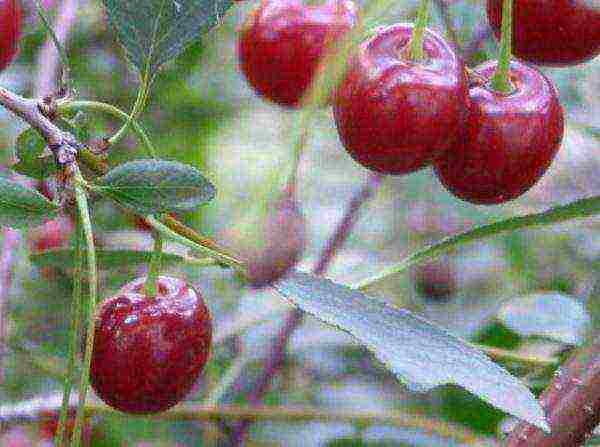 Cherry grade Mtsenskaya
Cherry grade Mtsenskaya
The tree rarely exceeds 2 meters in height, the crown is oval. Average, one berry weighs 4 grams, skin color is maroon... Most often, the fruits of the Mtsenskaya variety are processed. The trees are characterized by good resistance to frost, drought and most diseases. They also have an attractive appearance, which is why they are often used in landscape design.
There are many undersized varieties of cherries, these include Lyubskaya, Molodezhnaya, Memory Mashkin, Shokoladnitsa, Vladimirskaya, Tamaris and Saratov baby.
The best cherry varieties for the southern regions of Russia
Such varieties are distinguished by excellent taste, low or medium frost resistance. Their cultivation is possible only in warm climatic conditions.
Sasha
On average, the tree grows up to 3-4 meters, the foliage is average. Fruiting occurs on annual shoots. The fruits are large, juicy, red. They are distinguished by excellent taste. The Sasha variety is frost-resistant, rarely exposed to diseases.... The first fruiting occurs in the 5th year of life, early ripening.
Garland
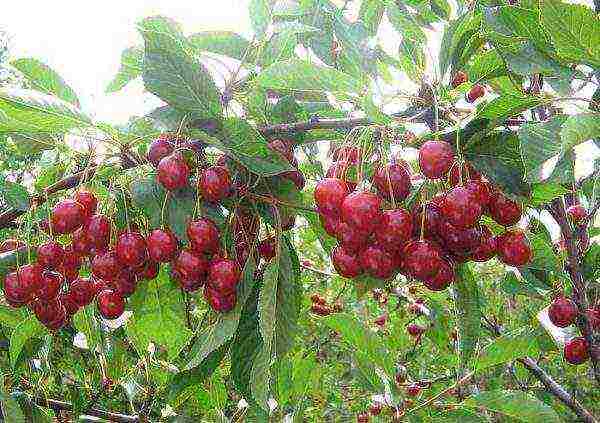 Cherry variety Garland
Cherry variety Garland
The growth of the tree is 3 meters, a large amount of foliage is formed on the branches. The Garland variety is distinguished by the presence of inflorescences, of which 5 fruits appear each. The berries are very large, juicy and tasty, the skin color is slightly darker than the flesh. The first crop can be harvested in mid-June as early as the 3rd year of life... The tree does not need additional pollination.
Also, for the southern regions, varieties such as Lyubskaya, Shpanka, Shokoladnitsa are suitable.
The best cherry varieties for the northern regions
Ashinskaya
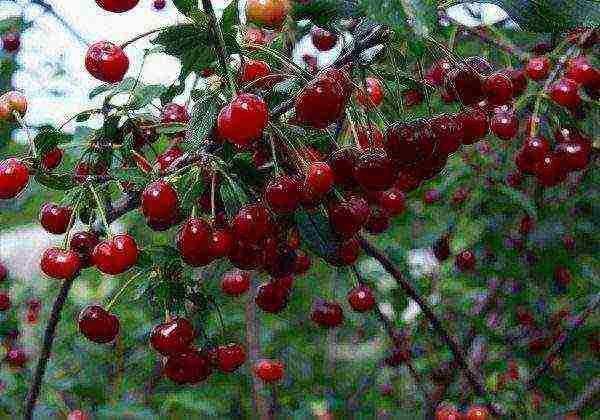 Cherry grade Ashinskaya
Cherry grade Ashinskaya
It is considered the best variety for the northern regions. A low-growing shrub, whose growth does not exceed 1.5 meters, can tolerate frosts down to -55 degrees... Also drought tolerant. Berries are dark in color, with dense pulp, slightly astringent, sweet and sour taste. The bone is small, easy to remove. Flowering occurs from the beginning of April, the shrub gives its first harvest at 4 years of age.
Ob
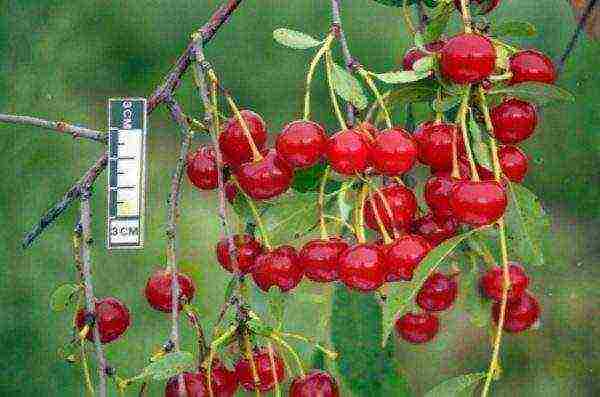 Cherry Ob
Cherry Ob
A short shrub that is only 130 centimeters tall. Fruiting occurs on annual growths. Berries are small, dark red in color, with a good taste and a small, well-separated seed... Fruits ripen in mid-July. The Ob is capable of withstanding severe frosts and drought, but is highly susceptible to pest attacks. The variety is self-fertile and does not need pollination.
Altai swallow
 Cherry variety Altai swallow
Cherry variety Altai swallow
A low-growing bush, no more than 150 centimeters high. The berries are round in shape and medium in size, distinguished by excellent taste and juiciness... Fruit ripening occurs in mid-July. The yield of the variety is very different from the trees growing in the southern regions, and is only 5 kilograms. The Altai swallow tolerates frost and drought well, and is immune to many diseases. It is also a pollinator for many cherry varieties.
For the northern regions, Novoaltaiskaya and Metelitsa varieties may be suitable.
The most delicious cherry varieties for Siberia and the Urals
Such varieties of cherries adapt well to the changeable climate of Siberia and the Urals, besides, they are distinguished by good yield and taste.
Ural ruby
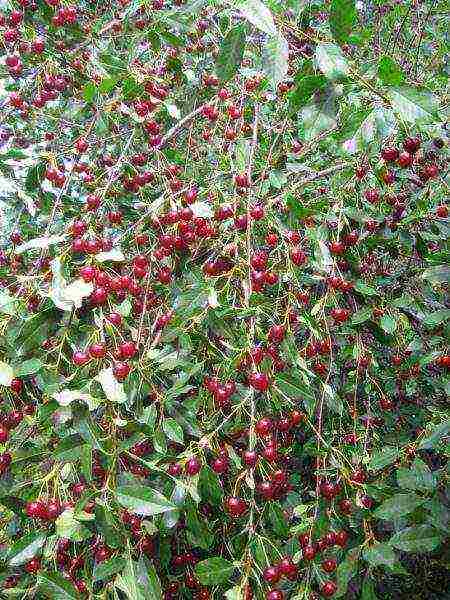 Cherry shrub Ural ruby
Cherry shrub Ural ruby
A shrub, whose growth is 1.5 meters, the crown is wide, the branches are weeping, growing downward. The leaves are wide, shiny, dark green in color, their shape resembles a boat. Fruits weigh only 3-4 grams, round in shape, dark red, juicy, sweet and sour taste... Ripen in mid-August. The variety is self-fertile, but it has a stable and good yield; an adult tree bears up to 10 kilograms of berries.
Lighthouse
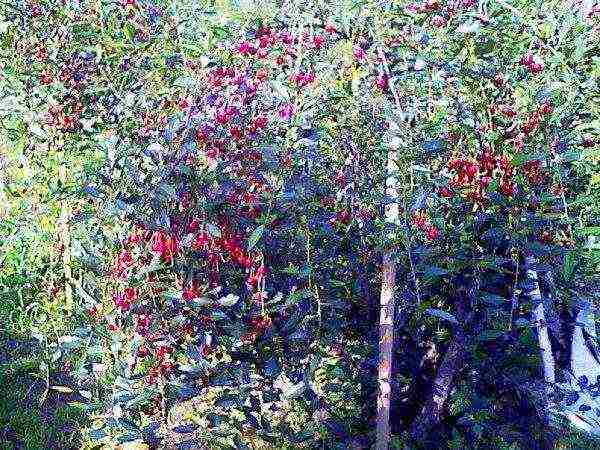 Siberian cherry variety Mayak
Siberian cherry variety Mayak
Lighthouse - a bush 2 meters high with a wide spreading crown and leaves folded into a boat. The Siberian variety is self-fertile, but when planted next to such varieties as Vole and Schedra, it gives the most abundant yields. Fruits gain weight up to 6 grams, dark red, sour-sweet taste. The crop can be harvested in early August, on average, one bush gives from 5 to 15 kilograms of fruit.
Also for these territories, the varieties Standard Ural, Schedra, Sverdlovchanka, Zagrebinskaya and Gridnevskaya are suitable.
The best cherry varieties for the Moscow region, description and care
The varieties that are best suited for the Moscow region must have good resistance to frost, and be unpretentious to the composition of the soil, a description of which can be found below.
Early varieties
From the category of early varieties of the Moscow region the varieties Molodezhnaya and Chudo cherry are best suited.
Among the mid-season varieties, one can distinguish Turgenevka, Excellent Venyaminova and Griot Moskovsky.
Griot of Moscow
 Cherry for Moscow Region Griot Moskovsky
Cherry for Moscow Region Griot Moskovsky
A tree with a spherical crown and matte leaves. The berries reach 3.5 grams in their weight, the taste characteristics are at the highest level, the fruits are suitable for various types of processing... Such a variety ripens in mid-July, the yield is above average, from one hundred square meters you can get up to a ton of cherries. Resistance to winter cold and return frost is excellent. Undergoes coccomycosis and monial burn.
Late varieties
Among the varieties of late ripening Zhukovskaya has recommended herself in the best way.
The undersized (dwarf) cherry varieties for the Moscow region include Molodezhnaya, Mayak, Tamaris, Bystrinka, Memory Mashkin and Malyshka.
Tamaris
The crown of the tree is small, rounded. Fruits are dark red with sparse brown spots. The pulp of the berries is juicy, the taste is sour. Cherries can be used both for fresh consumption and for various processing, the transportability of the fruits is average. You can harvest the crop in early August. The variety has good frost and drought resistance.
In memory of Mashkin
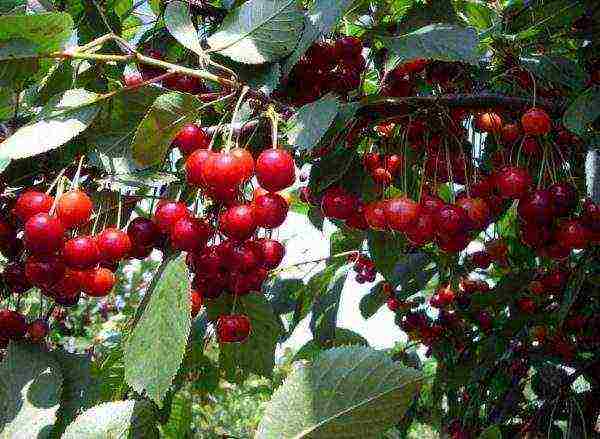 Cherry variety in Memory of Mashkin
Cherry variety in Memory of Mashkin
The crown of the tree is spreading, drooping, spherical in shape. The fruits are large in size, grow up to 5 grams, with their own dessert taste, they often become a decoration of any garden. Maturation occurs in mid-July... Resistance to frost and sore immunity is average.
Self-fertile varieties
The most popular self-fertile varieties for the Moscow region are Apukhtinskaya, Lyubskaya, Zagorievskaya, Volochaevka, Shokoladnitsa, Vstrecha, Garland and Cinderella.
Cinderella
Medium-sized tree, forming fruits weighing 4 grams, rounded oval and light red in color, sweet and sour taste. The harvest ripens in mid-July, from one tree you can get up to 15 kilograms of berries... The frost resistance of the tree itself and of the flower buds is excellent. The variety does not require additional protection against fungal diseases.
Breeders have bred a huge number of cherry varieties, which makes it possible to grow this crop in all corners of Russia. For the most part, all trees have good to medium frost resistance and bear sweet and sour fruits.... Each gardener can choose and plant the cherry that will decorate his particular plot.
More than two millennia have passed since the cherry took root on the European continent. Today, there are a huge number of varieties of this popular culture. How do they differ, which varieties can be called the best?
Description of cherry varieties
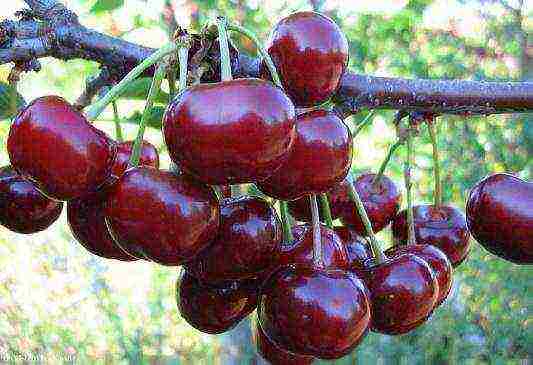
Cherry varieties
Like any berry crops, cherries can have different ripening periods. Early cherries pleases with the harvest of berries in the first half of June. There are varieties Pamyat, Bulatnikovskaya, Enikeeva, Bagryanka, Sania, Vladimirskaya, Vasilievskaya.
Cherry, medium in terms of ripening, gives a harvest in early July. Popular varieties: Zagorievskaya, Molodezhnaya, Radonezh, Vstrecha, Toy, Nochka. Late ripening is considered to be the period from late July to early August. Popular varieties in this category: Zhuravka, Turgenevka, Volevka, Rubinovaya, Lotovaya, Rusinka, Gorkovskaya.
The indicated ripening times are relative - they shift in one direction or another depending on climatic conditions (in the south, the berries ripen earlier, and in the north - later).
All cherry varieties can be divided into two groups - bushes and trees. Bush-like forms form dense growth and have a spherical crown. The harvest is mainly given by annual branches. The height of bushy forms does not exceed four meters. Popular varieties: Crimson, Vladimir, Lyubskaya. The bush bears fruit for about twenty years.
Tree-like forms yield a crop on bouquet branches. Popular varieties: Rusinka, Bulatnikovskaya, Turgenevka, Nord Star. Fruiting period of the tree: about thirty years.
Self-fertile varieties of cherries
Cherry in many cases is self-fertile (plants need proximity to pollinating varieties). There are also self-fertile varieties (without the participation of the pollinator, such plants are able to set a certain percentage of fruits). If pollinating varieties are planted next to self-fertile varieties, then the yield will increase.Popular varieties: Garland, Brunette, Cinderella, Shokoladnitsa, Erdi Betermo, Ksenia, Nochka, Vstrecha.
Cherry variety Molodezhnaya
The late variety - Molodezhnaya cherry (fruit ripening period - the end of July) has proven itself well. Self-fertility of this variety is 18%. The percentage of fruit set increases when adjacent to such varieties as Meteor, Nord star, Turgenevka. You can plant this variety next to a sweet cherry. Plants are characterized by high productivity and good frost resistance. This variety is not afraid of droughts. The berries are large (average weight 5-6 g). They withstand transportation well. The fruits are tasty, juicy, with dense pulp and pleasant aroma. The plant is weak, with a weeping crown. It can be a pollinator for many late varieties.
Recommendations by region
Cherry varieties grown in the Moscow region are characterized by a high degree of resistance to low temperatures and diseases (mainly to coccomycosis). The most popular varieties: Lyubskaya, Turgenevka, Apukhtinskaya, Coral, Crimson, Vozrozhdenie, Volochaevka, Toy, Zhukovskaya, Crystal, Molodezhnaya.
The varieties for the Urals and Siberia are characterized by high frost resistance. In these regions, high-yielding early-growing varieties are grown, such as Zagrebinskaya, Sverdlovchanka, Gridnevskaya, Polevka Michurina, Standard of the Urals.
In a temperate continental climate (in Central Russia) the following varieties are recognized: Turgenevka, Morozovka, Lebedyanskaya, Zhukovskaya, Dessertnaya Morozovoy, Vladimirskaya, Apukhtinskaya. All these varieties are adapted to moderately frosty winters and wet summers.
The best varieties of cherries
The best cherry varieties are those that are characterized by high yields and good fruit taste. The rating of folk favorites includes varieties Turgenevka, Molodezhnaya, Nefris, Waiting, Nochka, Biryulevskaya, Malyshka, Alpha, Hortensia.
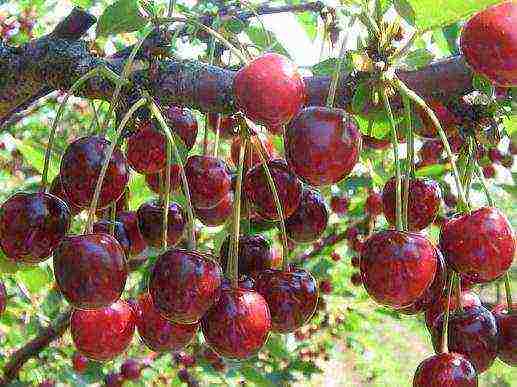
Cherry variety Griot Moskovsky
The variety Griot Moskovsky is of great interest. The fruits of such cherries are suitable for any kind of processing. They can also be consumed fresh. The variety is self-infertile - the pollinators are such varieties as the Pink Flask and Vladimirskaya. The variety is fast-growing, the ripening period for berries is July 15-20. Productivity is above average. This cherry is not afraid of frost. The plant has an average height (2-2.5 m). Fruits are large, round, juicy, dense enough, dark red, sweet and sour.
The sweetest varieties of cherries
Cherry varieties bred by crossing with another popular berry crop, cherry, are characterized by the greatest sweetness. Hybrid varieties adopt useful characteristics from their "parents": large-fruited, frost-resistant, disease-resistant. The category of sweet berries includes such varieties as Toy, Vladimirskaya, Pink bottle, Meteor.
Variety Wonder cherry
Miracle cherry is one of the most famous varieties. It is characterized by resistance to fungal diseases, good winter hardiness, high weight of berries (10 g). The fruits are juicy and sweet. They are colored dark red. Average yield is 15 kg per tree. Ripening period is average.
Large varieties of cherries
Large berries are considered, the weight of which exceeds 5 g. This category includes the varieties Volochaevka, Black large, Molodezhnaya, Dessertnaya Morozova, Pamyat Yenikeeva, Podbelskaya, Shalunya, Toy.
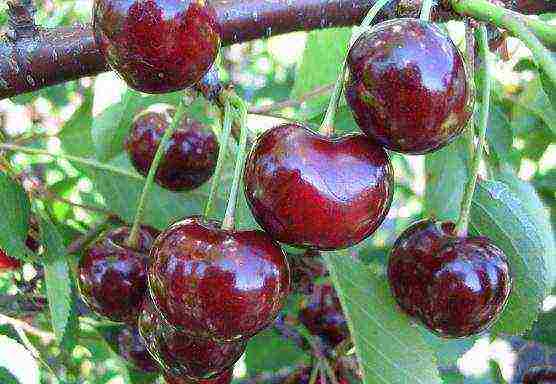
Cherry variety Meeting
The Vstrecha variety has proven itself well. The height of the plant does not exceed two meters. The crown is thick and drooping. The variety gives large yields of berries. Plants are resistant to drought and cold weather, as well as to diseases (coccomycosis, moniliosis). The average fruit weight is 8.6 g. The shape of the berries is flat-round, the color is dark red. The variety belongs to the category of partially self-fertile. To increase the yield, it is worth planting nearby varieties such as Minx, Perceptible, Samsonovka.
Low-growing cherry varieties
The height of a dwarf cherry (shrub or tree) usually does not exceed 1.7-2.5 m. At the same time, in terms of yield, low-growing varieties are not inferior to their tall "relatives". They have a lush, spreading, fast-growing crown. The average weight of the berries is 5 g. Their color and shape depend on the particular variety - the berries can be either dark or light red. The advantage of low varieties is that they are not afraid of the winds (branches break less). Low trees are easier to care for, and harvesting is easy. Dwarf cherries are unpretentious to growing conditions, they are not afraid of frost. Berries tend to have a firm flesh that allows them to be transported. Popular undersized varieties: Lyubskaya, Mtsenskaya, Tamaris, Bystrinka, memory of Mashkin.
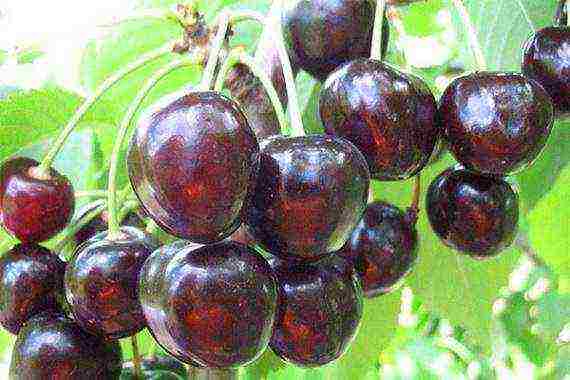
Cherry variety Shokoladnitsa
The variety Shokoladnitsa is widely known. The weight of the berries of this variety is 3.5 g, they are colored dark red, almost black. The fruits have a moderate sourness (more sweetness is felt). The yield is high, the ripening period is medium (mid-summer).
Cherry varieties: reviews
Judging by the reviews, the most interesting are low-growing high-yielding varieties. Of course, not all berries have ideal taste indicators, but it is not difficult to find the variety that is optimal in all parameters.
Many are accustomed to the fact that cherries are sour. But not everyone knows that there are varieties with very juicy and very sweet fruits. Taste them - and you will forever change your attitude towards cherries for the better!
It is noteworthy that these varieties were appreciated not only for the sweet taste of rather large berries. They are also distinguished by high yield and excellent presentation. These plants can be cultivated in central Russia and enjoy delicious fruits every year.
1. Volochaevka
This is a hybrid of popular cherry varieties - Lyubskaya and Vladimirskaya. With proper care of the plant, about 15 kg of juicy berries can be harvested from one tree annually.
The tree is medium-sized, with a rounded crown of medium density. The leaves are dark green, shaped like an inverted egg. Fruits are medium in size, deep red in color. Sweet to taste, with a slight sourness.
Inside the berry there is a small bone, which is easily separated from the very juicy and aromatic pulp, which has an excellent dessert taste.
This variety has a drawback: it has an average frost resistance and, under unfavorable growing conditions, can be affected by fungal diseases. In a rainy summer, he often suffers from coccomycosis.
| Entering fruiting | Tree height (m) | Fruit weight (g) | Harvest | Pollinating varieties |
| 3-4 years after planting | 3-3,5 | 4,5 | July 20-25 |
Self-fertile variety - in pollinators does not need |
2. Zhivitsa
This is a hybrid of cherry and sweet cherry, bred in Belarus. The mid-early variety Zhivitsa fell in love with many gardeners for its excellent frost resistance and plant resistance to coccomycosis and monilial burn.
The tree is medium-sized, with a rounded crown. The fruits of the so-called sweet cherry are medium-sized, round, dark red. They have a small bone, which separates well from the juicy pulp of a dark red color with a pleasant sour-sweet taste. The juice is also distinguished by its rich color and good taste.
It is thanks to crossing with cherries that this hybrid has sweeter berries than ordinary cherries. And besides, they contain many useful organic acids.
| Entering fruiting | Tree height (m) | Fruit weight (g) | Harvest | Pollinating varieties |
| 4 years after planting | 3 | 3,7 |
End of June - early July |
Seedling No. 1, Novodvorskaya, Vianok; cherry varieties, blooming at the same time with Zhivitsa (for example, Narodnaya, Syubarovskaya) |
3. Tamaris
The closest relative is the black consumer goods cherry, which also has good taste. However, this variety is self-fertile (does not pollinate on its own) and gives a small yield.
Therefore, Tamaris is a more improved version, which differs in rather large oval-shaped berries with a very juicy and tender pulp (with a slight sourness) of a dark red color.
The tree itself is of short stature, but has a spreading crown of a reverse pyramidal shape. For this reason, the plant is easy to care for and there is no need to build a high ladder when harvesting. And another advantage of this variety is that it is resistant to frost and coccomycosis.
Despite the fact that the Tamaris variety is self-fertile, it is recommended to plant such pollinator varieties as Turgenevka, Zhukovskaya, Lyubskaya next to it. This will significantly increase yields.
| Entering fruiting | Tree height (m) | Fruit weight (g) | Harvest | Pollinating varieties |
| 2-3 years | 1,7-2 | 4,3-5 |
End of July - early August |
Self-fertile variety - in pollinators does not need |
4. Chocolate girl
This variety got its name from the very beautiful, chocolate color of the berries. The plant quickly gained popularity not only for the excellent taste of the fruits, their attractive appearance, but also for their good winter hardiness, as well as short stature.
But keep in mind that a rich harvest can be harvested if the tree receives enough light. Therefore, for a seedling, it is best to choose a place on the southern side of the plot and not "settle" tall trees near, which will create shade. Then from one adult cherry tree you can collect about 12 kg of delicious berries.
Fruits of the Shokoladnitsa variety have a rounded shape and maroon (almost black) color with a glossy sheen. The pulp is red, juicy, sweet and sour. Moreover, it has a cherry flavor.
To get a more generous harvest, Shokoladnitsa should be planted next to the Griot cherry or Vladimirskaya and Sklyanka cherries. This will improve the pollination of trees.
| Entering fruiting | Tree height (m) | Fruit weight (g) | Harvest | Pollinating varieties |
| 4 year | 2,1-2,5 | 3,5-4 |
Second half july |
Self-fertile variety - in pollinators does not need |
5. Spunk
Spanka is a cherry / sweet cherry hybrid that comes in several varieties. The most popular are Shpanka dwarf, Shpanka early, Shpanka large-fruited, Shpanka Kursk, Shpanka Shimskaya, Shpanka Bryansk and Shpanka Donetsk. Basically, these are zoned varieties, which practically do not differ in their characteristics. In central Russia, large-fruited Shpanka is usually grown.
This is a vigorous tree with a dense crown of reverse pyramidal shape. The fruits are rounded, slightly flattened and dark, maroon-brown in color. They, like cherries, hang on the tree in garlands or along the entire one-year growth. The pulp of the berries is sweet, with a hint of sourness, light yellow in color. The juice is almost transparent.
Shpanka tolerates severe winters with frosts down to -35 ° C and drought. And also, as a rule, does not suffer from coccomycosis.
This variety is considered self-pollinating, but the level of self-fertility is no more than 10%, therefore, to increase yields, it is recommended to plant pollinating varieties next to it.
| Entering fruiting | Tree height (m) | Fruit weight (g) | Harvest | Pollinating varieties |
|
After 5-6 years after landing |
Until 6 | 4-5 |
End of June - early July |
Griot Ukrainian, Griot Ostheim |
We hope our detailed description will help you choose the right sweet cherry variety, because according to the reviews of experienced gardeners, all of the listed plants are good. And with proper care, the tree will certainly respond with a rich harvest of tasty, juicy, aromatic and sweet berries.
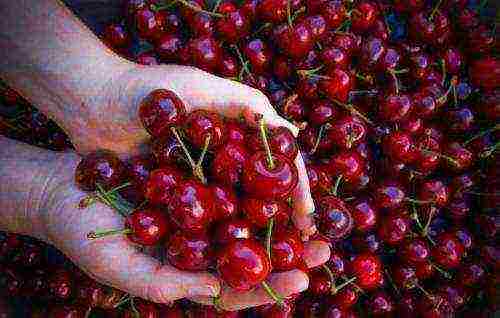
Cherries are a very healthy berry, rich in vitamins and minerals. It is used for freezing, processing and fresh consumption. If you have even a small summer cottage, you can grow a tree yourself, but do not rush to plant the first variety that comes across. Choose the best cherry that will maximize your yield and adapt perfectly to your climate.
Which high-yielding cherry varieties are best grown?
When purchasing a seedling, pay attention to its yield indicator. Gardeners have identified several varieties that, in their opinion, are the most productive in a subsidiary farm:
· "Night";
· "Black large";
· "Toy".
The Nochka variety is considered the highest-yielding variety. Up to 70 kg of berries can be harvested from one adult tree. The harvest ripens at the beginning of summer, the return is friendly. The berries are dark red, large, fleshy and sweet. The variety is notable not only for stable yields, but also for a high threshold of winter hardiness and disease resistance. Recommended for growing in the Moscow region and central Russia.
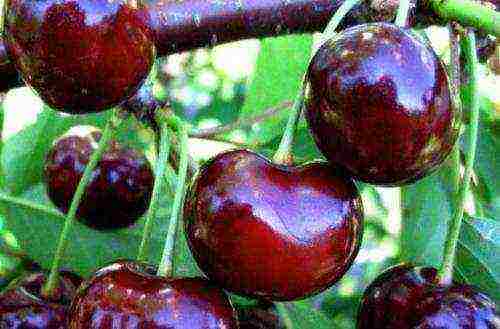
The "Toy" variety has an excellent yield. The tree is vigorous, often exceeding 7 m in height. Begins to bear fruit three years after planting. The average yield of an adult cherry is up to 50 kg. The berry is large, dark in color, with a pleasant sweet and sour pulp. The skin is thin, the stone is easily separated. The variety has a high threshold of winter hardiness and is not susceptible to drought, but flowers and buds can suffer during prolonged spring.
Cherry "Black large" is no less popular. The tree is medium-sized, bears fruit in the middle of summer in the third year after planting. The berries are large, dark cherry in color, soft and tasty. The variety is self-fertile, with good pollinators, the yield reaches 30 kg per tree. The advantage of the variety is its high frost resistance; cherry can withstand temperatures as low as -35 ° C. With proper agricultural technology, it can be grown in the northern regions of the country.
The best self-fertile varieties of cherries for the garden
Recently, self-fertile tree varieties have gained particular popularity. They allow you to significantly save space in the garden and at the same time get a good harvest. Gardeners should pay attention to the following varieties:
· "Garland";
· "Youth";
· Cinderella.
The "Garland" variety is considered one of the earliest, suitable for cultivation in the northern regions of the country. The tree is completely self-fertile with good yields, withstands temperatures down to -35 ° C. On average, from 10 to 20 kg of cherries are harvested from it per season. The berries are large, dark in color, dense, but juicy. The crop tolerates transportation well and does not lose its presentation for a long time.

Cherry variety "Molodezhnaya" is not only self-fertile, but also undersized with a drooping crown. The height of an adult plant does not exceed 2.5 m. The berries are red, sweet and sour in taste, with a small stone that separates well. The advantage of the variety is its increased winter hardiness and disease resistance. The tree painlessly tolerates temperatures down to -30 ° C. The yield of the variety is up to 10-12 kg per tree.
Among the mid-ripening self-fertile varieties, the Cinderella cherry stands out. With good care, it is possible to collect up to 15 kg of cherries. Berries of medium size, bright red, sweet and sour taste. The tree does not need treatment from pests and diseases, it tolerates low temperatures well in winter.
The best of low-growing cherry varieties
Low-growing varieties of cherries have always been appreciated among amateurs. The following varieties are especially popular:
· "Shokoladnitsa";
· "Lighthouse";
· "Brunette".
Variety "Shokoladnitsa" is notable for its fruits of dark chocolate color. The tree does not exceed 2.5 m, completely self-fertile. The berries are medium in size, very tasty and sweet. The pulp is dark red, the stone is small and well separated.
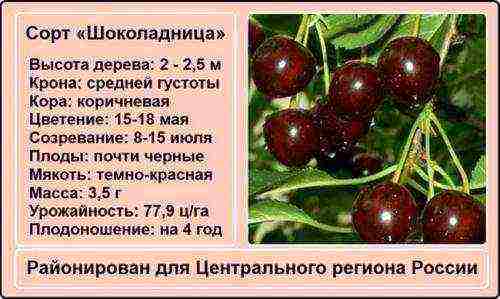
The bush variety "Mayak" is used for industrial cultivation. The plant does not exceed 2 m, but it requires enough space. His crown is spreading, thick. The berries are large, maroon, with a characteristic shine. The cherry taste is delicate, sweet. Productivity up to 15 kg per bush. The berries ripen in early August. The variety is designed for cultivation in Siberia.
Cherry "Brunetka" is popular not only for its small tree height, but also for its early maturity, self-fertility and regular harvests.In addition, it is a variety with a high threshold of winter hardiness, and is recommended for cultivation in central regions. The berries are dark, medium in size, ripen in the middle of summer, sweet and sour in taste. Suitable for processing and fresh consumption. Productivity up to 10 kg per tree.
The most winter-hardy of the best cherry varieties
The varieties for the northern regions and Siberia are chosen especially carefully. Gardeners in this area will like the following varieties of cherries:
· "Ashinskaya";
· "Altai Swallow";
· "Generous";
· "Sverdlovchanka";
· "Blizzard".
Variety "Ashinskaya" is rightfully considered the best among winter-hardy varieties. The shrub tolerates frosts down to - 55 ° С. Its height does not exceed 1.5 m, flowering and fruiting occurs in the fourth year of cultivation. The berries are dark, with a specific astringent taste, with a small stone.

The Altai Swallow variety, although it does not give large yields, perfectly tolerates the harsh climate of this area. The shrub grows up to 1.5 m, bears fruit in the middle of summer, with good care, up to 5 kg of berries are harvested from it. Cherries of excellent taste, medium in size, dark.
Cherry "Generous" of bush type is very popular. The plant reaches 2 m in height, unpretentious, bears fruit on last year's growths and bouquet branches. The bush has an average flowering period, begins to bear fruit in 3-4 years of cultivation. The yield is stable over the years. The bush is self-fertile. Frost resistance up to - 45 ° С. The berries are bright red, sweet and sour, do not crack on the branches. Suitable for all types of processing and fresh consumption.
Medium late varieties include Metelitsa cherry. The bush grows up to 1.5 m, begins to bear fruit early, the yields are stable. The berries are medium in size, red, with tender and juicy flesh, sourness is present in the taste. The yield is average, with good agricultural technology, up to 5 kg are harvested from the bush.
Among the late-ripening varieties for Siberia, the Sverdlovchanka cherry stands out. The tree begins to bear fruit early, gives stable yields every year. Flowers and shoots are not susceptible to recurrent frost. The tree does not exceed 2 m in height, blooms at the end of May, is partly self-fertile. For better yields, pollinators are grown nearby. The berries are large, dark cherry in color, sweet, with a dense skin. Transport is well tolerated, do not lose their presentation. The variety is intended for all types of processing.

